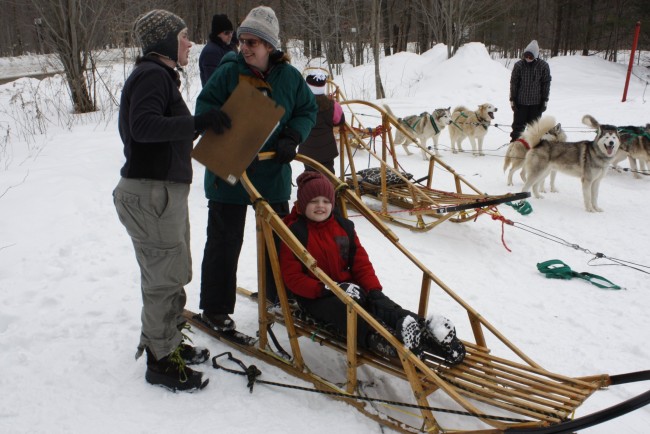“The first rule of dogsledding is to hang on, and the second is not to let go,” quips Emily Kurvell, our guide. She makes it sound easy, but looking at the 18 huskies yelping wildly and straining at their leashes, I’m more than a little nervous.
The younger drivers in our group don’t seem to have the same apprehension. Two young girls from Florida in shiny new snowsuits are jumping up and down and seem as eager to go as the dogs are.
“The dogs love it!” says Kurvell. “It’s what they’re bred to do.”
The Florida family, who tells us they wanted to do something that no one else back home has done, are among the 10 of us gathered around the sled, here in Haliburton Forest. This 60,000-acre wilderness reserve is located less than three hours from Toronto, just south of Algonquin Park. The thick, mixed hardwood and evergreen forest contains 50 lakes and more than 200 species of birds and animals, making it an idyllic setting for this adventure. But, at the moment, our minds are focused only on the dogs and our instructions.
“Hike up!” is the command for “go” and “whoa!” is “stop.” “Gee!” and “Haw!” are right and left, but don’t worry if you forget which is which, since most of the dogs don’t know, either. “Up front!” is another important command, meaning “behave!” Mmm, wonder if that will work for my kids? Surprisingly, we never hear the word “mush!”
“The most important thing to remember is to keep one foot hovering above the brake at all times and keep your eyes on the dogs, not the sleigh,” we are told. For some reason, I never imagined a dogsled having brakes, but I’m about to find out just how essential they are.
Kurvell tells us to pet our lead dog to build a relationship. “Go easy on me,”I whisper to Tango as I scratch behind his ears.
I’m now at the helm, wishing desperately I was the passenger, and the dogs are making an awful racket. It all happens quickly.
“Are you ready?” I’m asked.
I freeze, and not from the cold. Even though I don’t answer, the dogs lurch forward, their muscled bodies easily pulling us. They run. Fast! I hold on for dear life. Every word of Kurvell’s instructions flies out of my mind as we zip along the trail.
It’s more like a roller-coaster ride for those long first few seconds until finally I remember the all-important brakes. I push down and the dogs slow down a fraction. I start to breathe again. My hands, still in a vice-like grip, begin to cramp.
Thankfully, the instructions begin to come back, so I use the brake, watch the dogs and hang on with all my might.
The dogs quiet down; yelping is replaced by panting and the swishing of the sled gliding through the snow. I loosen my grip ever so slightly, the cramp subsides and the activity becomes an enjoyable one. Blanketed in snow, the forest appears magical and the experience almost meditative with an occasional surge of adrenaline occurring at sharp turns, when I, not the dogs, let out a yelp.
The 90-minute tour is over all too quickly and we’re back at the starting point. I give Tango a pat and thank him for a great ride.
At the kennels, we discover that they have more than 130 Siberian huskies. The males and females are separated and we aren’t permitted in the male enclosure because of the risk of being bitten as the dogs vie for social positioning. Inside the female sled dog enclosure, we all enjoy petting and playing with huskies. The Florida girls’ snowsuits now have a few marks on them and they giggle as one of the dogs steals a glove.
Dogsledding is only one part of this remarkable conservation area. Peter Schleifenbaum, the reserve’s principal owner, has worked for more than two decades to preserve the environmental integrity of the forest while making it economically viable, earning him Canada’s first Forest Stewardship Council environmental certificate.
Visitors can enjoy more than 215 miles of hiking, biking, skiing and snowmobile trails and numerous outdoor recreational activities.
At their Wolf Centre, you can observe an unsocialized pack of wolves through one-way glass. The social dynamics of the group are fascinating, as are the numerous displays inside.
If you go:
Haliburton Forest and Wildlife Reserve offers several levels of dogsledding excursions. All equipment, snacks and meals will be provided, but riders should dress in warm layers with good boots, gloves and hats. Participating children must be at least 6 years old.
The fee for a two-hour introductory tour (one hour of instruction, one hour on the trail) is $115 per person; $165 for adult with child passenger; $200 for two adults sharing a sled.
Half-day tours, which cover 20 kilometers with a midtour stop for a warm drink and stories, are $175 per person; $245 adult with child; $300, two adults.
Full-day tours include lunch at a cabin and cover about 40 kilometers; price is $300 per person.
All tours include a kennel tour.
Accommodations on site include housekeeping cottages and log cabins. There are also plenty of other options nearby, from basic yurts in Algonquin Park to the Foxwood Resort, where you’ll find cozy year-round cottages—perfect for unwinding after an exhilarating dog sled ride in the Ontario wilderness.
For reservations, call (705) 754-2198; for more information about dogsledding and the park’s other programs, including snowmobiling, snowshoeing and wolf watching, go to haliburtonforest.com.


